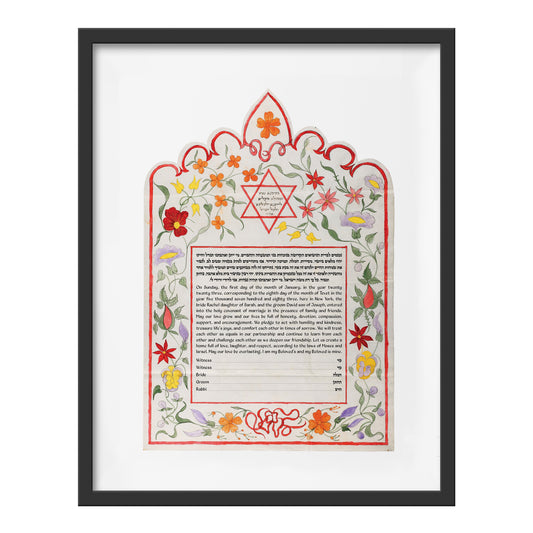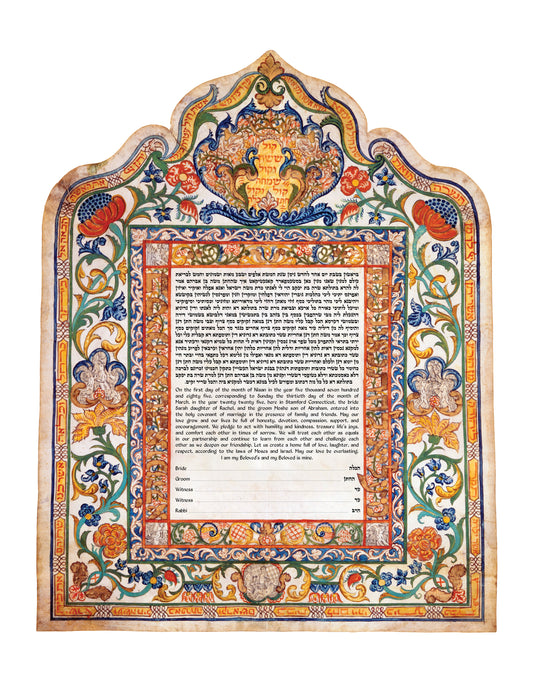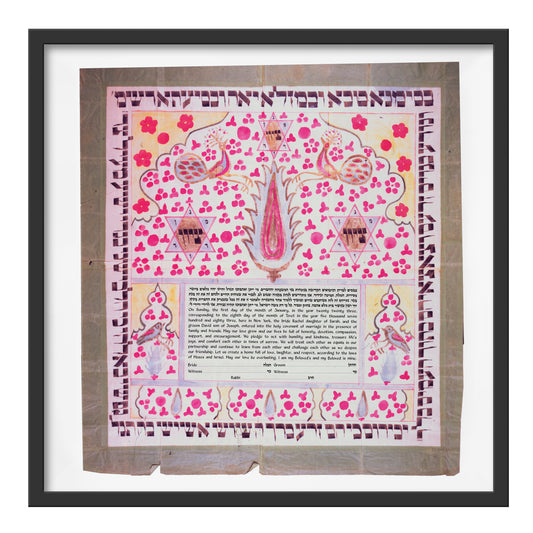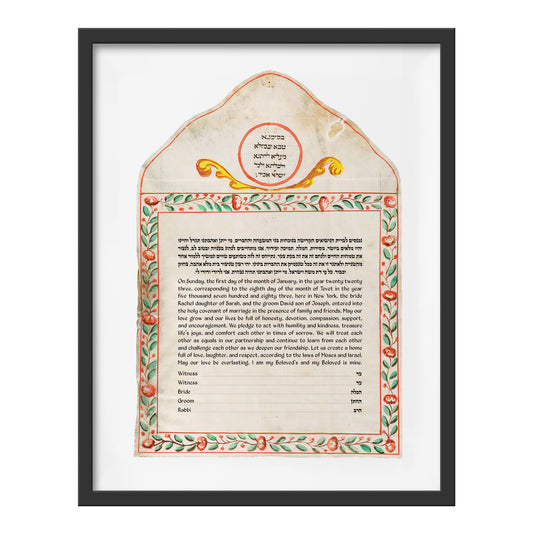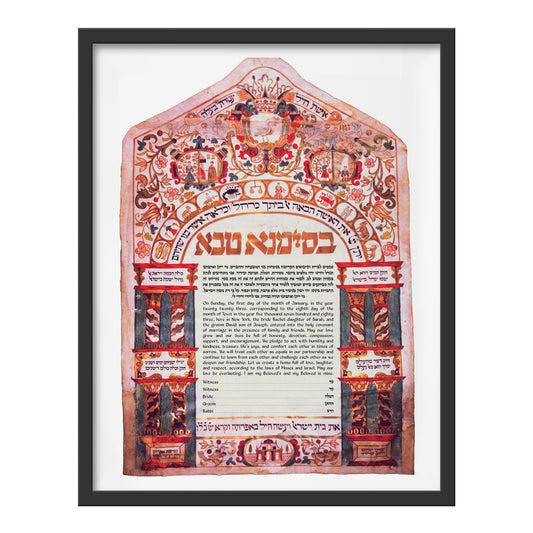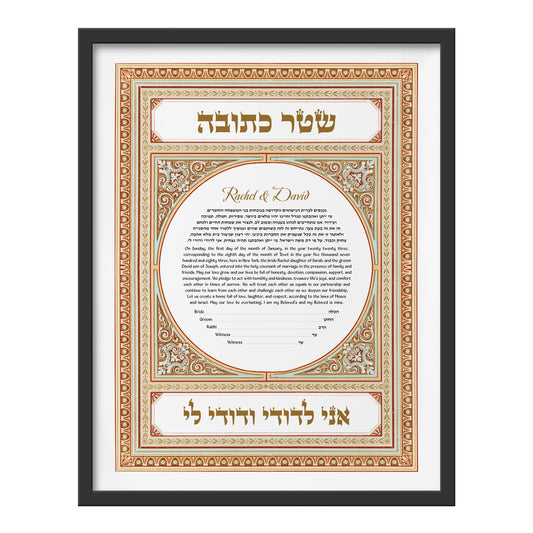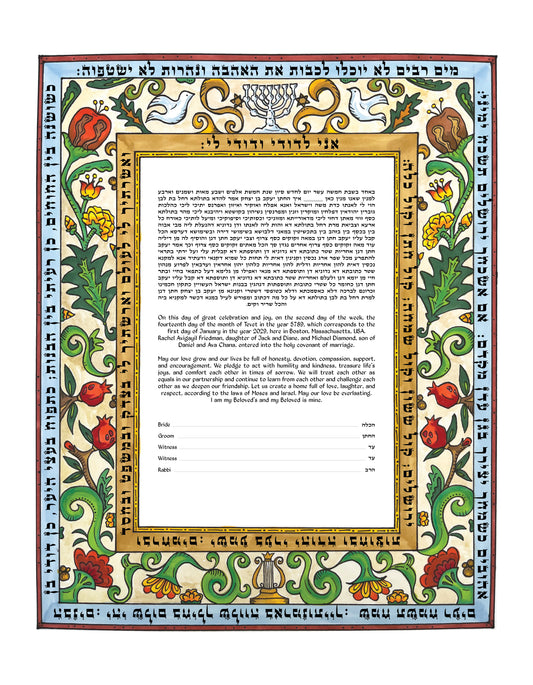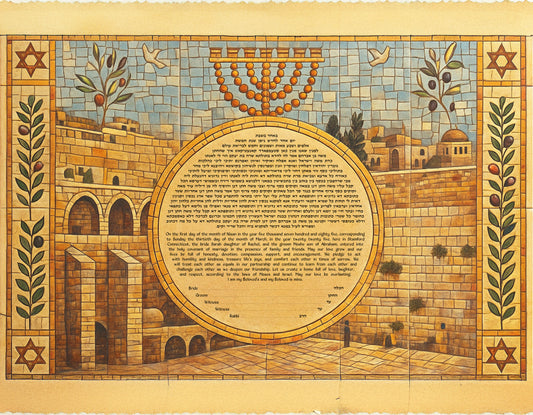Collection: Traditional Ketubahs
-
Ketubah. Bombay, India, 1911
4 reviewsRegular price From $279.00 USDRegular priceSale price From $279.00 USDUnit price / per -
Ketubah: Livorno, Italy, 1698
No reviewsRegular price From $229.00 USDRegular priceSale price From $229.00 USDUnit price / per -
Ketubah. Ancona, Italy. 1906
2 reviewsRegular price From $229.00 USDRegular priceSale price From $229.00 USDUnit price / per -
Ketubah. Trieste, Italy. 1774
3 reviewsRegular price From $229.00 USDRegular priceSale price From $229.00 USDUnit price / per -
Ketubah. Isfahan, Iran. 1933
No reviewsRegular price From $219.00 USDRegular priceSale price From $219.00 USDUnit price / per -
Ketubah. Ancona, Italy. 1846
No reviewsRegular price From $199.00 USDRegular priceSale price From $199.00 USDUnit price / per -
Ketubah. Venice, Italy. 1732
1 reviewRegular price From $229.00 USDRegular priceSale price From $229.00 USDUnit price / per -
Ketubah. Padua, Italy. 1722
No reviewsRegular price From $199.99 USDRegular priceSale price From $199.99 USDUnit price / per -
Vintage 19th-Century Style Ketubah
1 reviewRegular price $199.99 USDRegular priceSale price $199.99 USDUnit price / per -
Italian Renaissance Ketubah: Art Painted Anew
1 reviewRegular price From $219.00 USDRegular priceSale price From $219.00 USDUnit price / per -
Jerusalem Mosaic Ketubah – Western Wall (Kotel) Art
No reviewsRegular price $229.00 USDRegular priceSale price $229.00 USDUnit price / per
The Timeless Beauty of Traditional Ketubahs: Embracing
Heritage and Commitment
A Ketubah is an ancient tradition that serves as the
foundation of any Jewish marriage. Read on to learn about this beautiful and meaningful
document and why a traditional ketubah is still relevant in modern times.
Ketubahs: A Jewish tradition embraced by generations
A Ketubah is a customary Jewish marriage contract that
couples have effectuated for centuries. This sacred covenant was first created to
protect women when entering marriage. Since ancient times, generations of
Jewish couples have embraced this tradition to lay out their commitments and
vows to each other.
Today many couples choose a traditional Ketubah for their
Jewish weddings. Traditional Ketubahs honor the rich history of the Jewish
people and allow couples to embrace their heritage while looking toward their
futures.
The historical significance of traditional Ketubahs
The Ketubah tradition dates back even before the Torah. In fact,
there are even a few references in the Torah to this marriage custom, yet the
Torah does not require it by law. Ketubahs became part of Jewish law around 360
CE and since then Jewish couples have entered into this sacred covenant.
Contrary to popular belief, the historical Ketubah was NOT a
contract for purchasing a bride. The Ketubah has always been and continues to
be a document where the husband lays out his intentions for the right to marry
the bride.
Historically Ketubahs were effectuated with a rabbi, the
groom, and two Ketubah
witnesses who served to ensure the document’s validity. The Ketubah was
signed after the participants said the relevant blessings and completed the
rituals. Only then could a wedding ceremony commence.
In ancient times, a Ketubah was fully enforceable by the
rabbinical courts. Today a Ketubah is more ceremonial, yet very meaningful for
many couples.
Elements of a traditional Ketubah
Traditionally, Ketubahs are written in ancient Aramaic text.
However, Jewish couples can choose from multiple different Ketubah
texts depending on their heritage, location, and values. For example, the
Rabbinical Council of America has its own text, while the United Synagogue in
the UK has a slightly different version. Sephardic, Heradi, and Yeshivish
couples often choose the strictest text that most resemble the ancient version.
Modern couples may also choose to use different texts or even English
translations for their traditional Ketubahs.
Traditional Ketubahs are generally written in a specific
format, with the date on top before the names of the bride and groom. At the
bottom of the text, there are signature lines for witnesses. While the bride
and groom traditionally do not need to sign the Ketubah, today’s couples can
add their own signatures to a traditional Ketubah.
Traditional Ketubah Designs
The tradition of decorating Ketubahs is almost as old as the
Ketubah tradition itself. In ancient times, scribes and artists created
beautiful Ketubahs on papyrus for couples to hang in their homes. Often the
designs focused on Jewish motifs and symbols. For example, it is very common to
see the Jewish star of David, hamsas (the five-fingered palm of a hand), and
Menorahs on Ketubahs. Some Ketubahs also depict passages from the Torah or show
images of Jerusalem and the Temple Mount.
Another common design theme in traditional Ketubahs is
nature. Images of palm fronds, the Tree of Life, or the Garden of Eden are also
very prevalent in traditional Ketubahs.
Hebrew words and quotes from Jewish literature are also used
in traditional Ketubahs. For example, you might see many traditional Ketubahs
with the text: “Ani L'dodi V'dodi Li," which translates to "I am my
beloved's and my beloved is mine."
Artists often choose watercolors, bright paints, or papercutting
to decorate traditional Ketubahs. Papercutting has been a traditional Jewish
folk art form since the Middle Ages and is very common for creating intricate
Ketubah designs.
Thanks to modern technology, historical Ketubahs can be reproduced
and digitally printed, and papercut designs can be laser cut. These advances
make traditional Ketubah designs accessible to anybody. Choosing a design with
historical significance is a great way to preserve tradition.
How to choose a traditional Ketubah
If you want a traditional Ketubah for your wedding, it is
smart to start your search early to ensure you have enough time to make a
design and account for personalization and shipping.
Your first step is to choose the traditional Ketubah text
that speaks to you. Orthodox texts are common, but you can choose a
conservative, reform, or even create your own text for your traditional
Ketubah.
Next, you need to decide what type of design you are looking
for. You might want to consider your heritage, aesthetic preferences, and the
values you and your partner hold. You can get a good idea of the design options
available by browsing online marketplaces or visiting galleries of local
artists.
Displaying and preserving your traditional Ketubah
You might want to display your new Ketubah during your
wedding. In traditional wedding ceremonies, the Ketubah is presented to the
bride in the presence of the guests. After the ceremony, you might want to
allow your guests to get a closer look at the beautiful design you choose.
You’ll want to make sure to have a frame or a shadowbox available to protect
the document from any potential damage.
After your wedding, you will want to hang your traditional
Ketubah on a wall in your home. This will serve as a constant reminder of your
vows and love for your partner and will honor your commitment to your Jewish
heritage.
You want to preserve your Ketubah to pass it down to future
generations who one day may take their own part in this ancient tradition.
The enduring beauty of traditional Ketubahs
Ketubahs are the foundation of a Jewish marriage and honor
the rich history and culture of the Jewish people. It’s important to find a
traditional Ketubah that speaks to you and reflects your heritage and values.
Traditional Ketubahs are timeless and will help you celebrate your love and
heritage for a lifetime.
WeddingKetubah.com works with many artists to design
traditional Ketubahs for modern couples. Browse our selection above.



